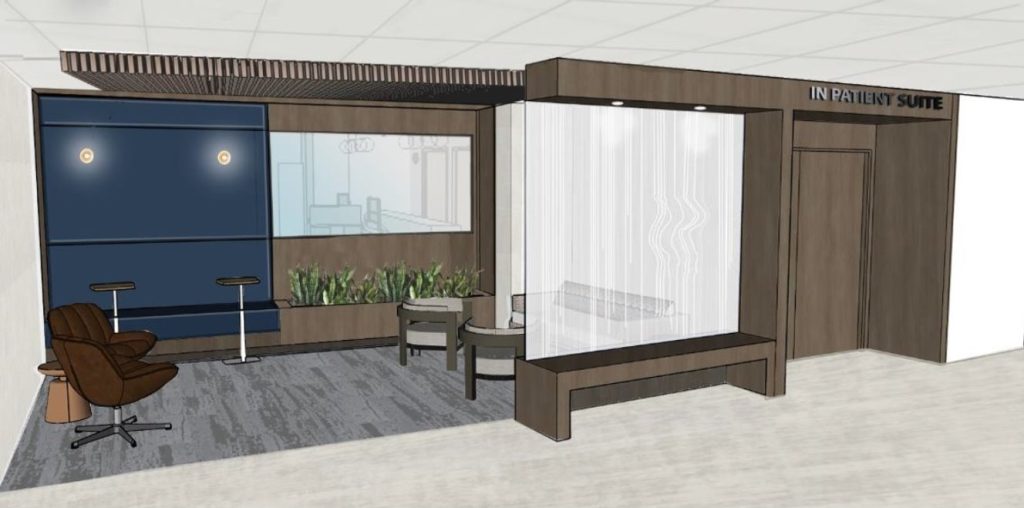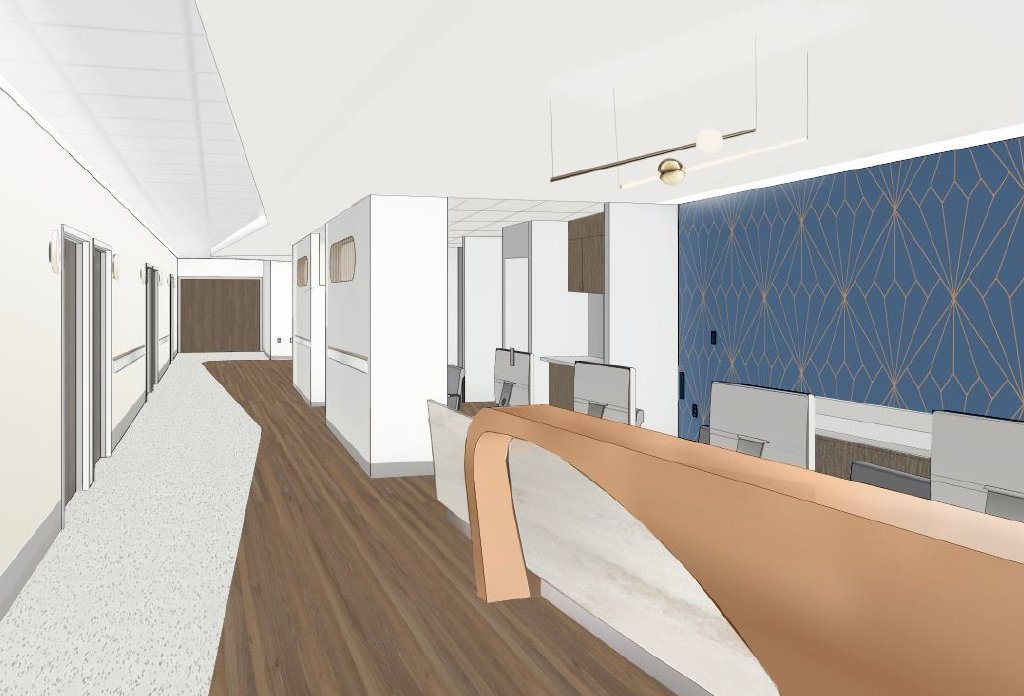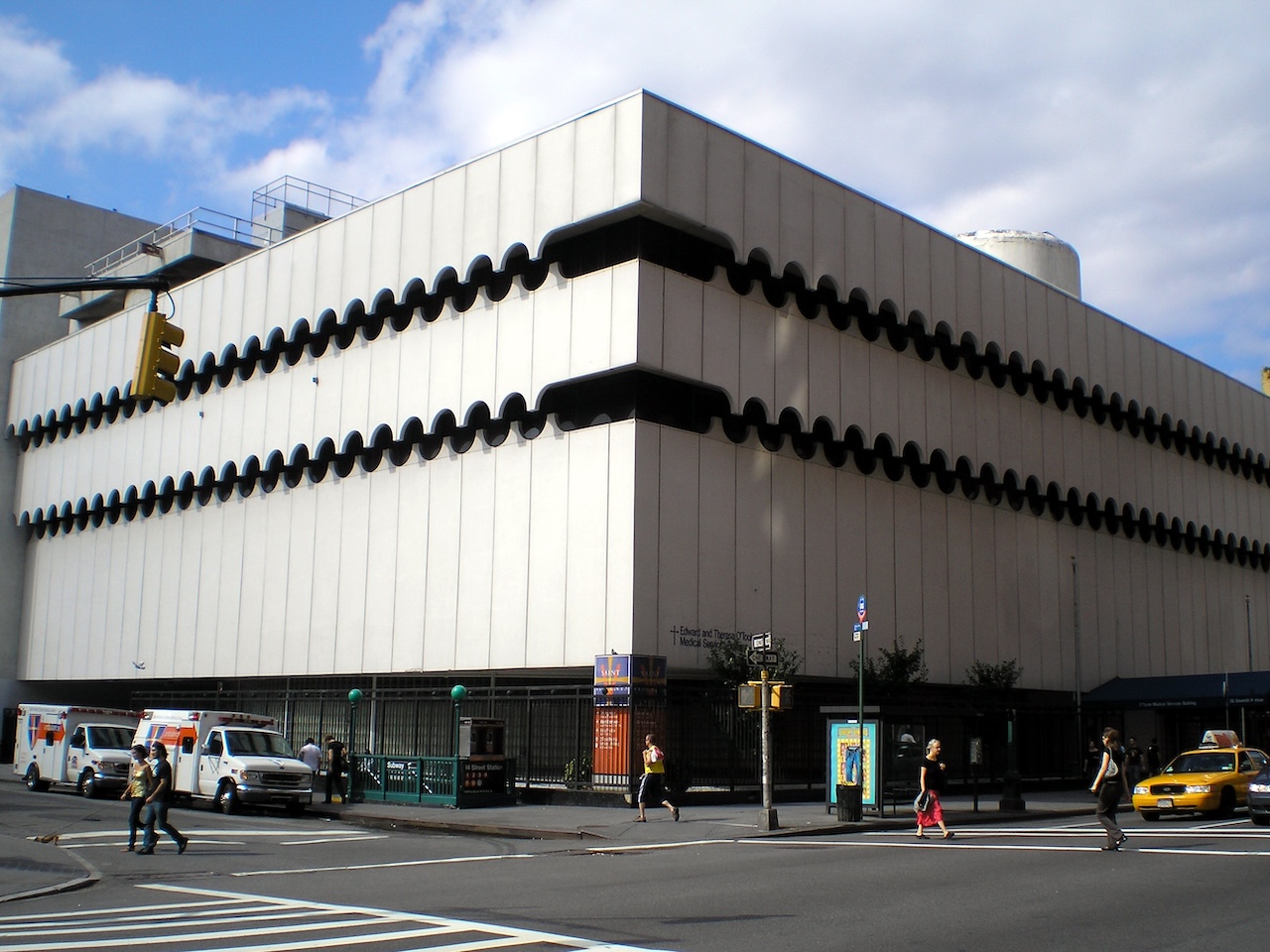BY LINCOLN ANDERSON | It’s taken a little while, but Lenox Health Greenwich Village is on track to open its first inpatient hospital beds in about a year from now.
Tracy Feiertag, who has been the health hub’s executive director for the past year, said that an inpatient suite with eight hospital beds is currently under construction, and that the center may eventually possibly add four more, for a total of 12.
Originally dubbed a “healthplex,” L.H.G.V. opened in 2014 on Seventh Avenue between 12th and 13th Streets in the former O’Toole Medical Services Building, which was part of St. Vincent’s Hospital. After the hospital abruptly closed in 2010, the Rudins, who went on to redevelop the hospital’s former main campus into a luxury residential complex, donated the O’Toole Building to Northwell Health, so that there could be a remnant of medical coverage for the community.
Rather than a full-service hospital, L.H.G.V. is a stand-alone emergency room. It also does ambulatory surgery and offers other services. Now, however, patients who undergo certain procedures there will be able to recover in a limited number of inpatient beds.
“We’re already more than an emergency room,” Feiertag said.

Feiertag actually was with L.H.G.V. when it opened in 2014, then left for a period for a corporate role before returning. She described the planned inpatient beds as being for “low-acuity, medical-surgical patients,” adding that most of them will be coming from the site’s emergency department.
Patients might stay in a bed for up to two to three days if, for example, they need IV hydration or antibiotics.
The Seventh Avenue facility also performs joint-replacement surgery on an outpatient basis. However, Feiertag said most people usually need 23 hours to recuperate after a knee or hip replacement, so that is another type of patient that the new beds could serve.
“The added inpatient beds, I think it’s very significant,” she stated. “I was rounding [doing her rounds] a couple of weeks ago in the emergency department, and I saw a couple in their 80s. He was going to be admitted [to Northwell’s Lenox Hill Hospital]. She said it was really hard for her because she can’t take the subway anymore, so it’s a $30 Uber there and $30 back. It made me sad.”

Feiertag said that, in this couple’s case, for example, if the husband could stay in an inpatient bed at L.H.G.V. instead of an Uptown hospital, clearly it would make a big difference for them.
At the same time that L.H.G.V. is adding some beds, it also will be opening up a cath lab, both for emergency and elective procedures, such as for stent placements. Meanwhile, on the other side of town, Mt. Sinai Beth Israel Hospital — which Mt. Sinai Health System is trying to close — has already relinquished its certification as a stroke center and STEMI center, the latter which treats heart attacks.
L.H.G.V. is certified as a primary stroke center. Feiertag said they are hoping, once the new inpatient beds are open, that E.M.S. will designate the facility as a stroke intake center, meaning its ambulances would drop off stroke patients there.
Mt. Sinai Beth Israel’s future hangs in the balance as the community, local politicians and health advocates are currently waging a furious fight to save it. A legal battle is also going on in court to keep the historic Gramercy hospital open. The state Department of Health recently ruled that Mount Sinai Health System’s closure application for the E. 16th Street hospital was “incomplete” and must be resubmitted.
Mt. Sinai argues that Beth Israel is a massive cash drain jeopardizing its entire health network. Hospital supporters, though, charge that Mt. Sinai itself has created the conditions to justify the shutdown so that it can, in turn, sell off the valuable property.
“I can’t say what’s going to happen with Beth Israel but we will be here for the community,” Feiertag assured.

Six months after its cath lab opens, L.H.G.V. also plans to get approval for electrophysiology — to treat heart arrhythmia and atrial fibrillation.
In addition, L.H.G.V. already provides comprehensive healthcare, physician practices located nearby, imaging (X-rays, MRIs, etc.), ambulatory surgery, robotic spinal surgery and orthopedics.
Small stand-alone facilities — meaning not connected to a full-service hospital and with no or few inpatient beds — are a growing trend.
“In some areas of the country, it’s called a ‘neighborhood hospital’ or a ‘micro-hospital,'” the executive director said. “It’s still a lower-acuity setting. We were the first [stand-alone E.R.] in Manhattan. Now there are a few in the city.”
Many people, though, seem to regard L.H.G.V. as if it were a full-service hospital.
“People walk in every single day with heart attacks, strokes and other kinds of trauma,” Feiertag explained, “even though it’s not an [officially designated] intake center.”
As for the impact of losing Mt. Sinai Beth Israel, she noted its emergency room saw 65,000 patients last year. So if the East Side hospital ultimately were to close, she assumes Bellevue, N.Y.U. Langone and New York-Presbyterian Lower Manhattan hospitals, as well as L.H.G.V., would all see additional E.R. patients.
“There’s always the possibility that whoever buys the [M.S.B.I.] property will do something there,” she noted. “One thing that’s possible is that they’ll keep the emergency room open.”
Asked if L.H.G.V. could physically expand to help fill the void if M.S.B.I., in fact, does close, Feiertag responded, “We don’t have the space. [What was formerly] St. Vincent’s Hospital is now condominiums.”
In addition, the L.H.G.V. building is an individual New York City landmark, making gaining approval for any alterations or additions there more challenging.
Over the years, some patients have complained of being hit with surprise medical bills after visiting L.H.G.V. However, Feiertag said there’s a simple reason for the higher cost of treatment.
“Emergency room bills are higher than urgent-care bills,” she explained. “The whole facility is an E.R. It has higher operating costs. If you walk into an urgent-care [facility] with a gunshot wound, they will not be able to treat you. We will, and there’s a cost associated with that.”
So, for more minor medical issues, she recommends going to a nearby urgent-care center.
Over all, though, Feiertag said, the community is happy to have L.H.G.V. providing the higher-level healthcare services that it does. And now it will be adding more, even as M.S.B.I. faces possible closure.
“We need healthcare in Downtown Manhattan,” she said, “but there will be less and less. Hopefully, our services will add some back.”


Ms Feiertag demonstrates a high level of caring and compassion. She is a strong role model for the health industry and women.
Thanks for this excellent news for the neighborhood. Eight inpatient beds with — perhaps — an additional four is a pittance compared to what St. Vincent’s Hospital had available, but it’s better than today’s zero.
Worth reiterating: while St. Vincent’s Hospital could have failed with no outside assistance (2 bankruptcies leaves little doubt there was A Problem), shortsighted neighborhood ideologues and activists majorly helped grease the skids and assured there’d be no alternative to replace St. Vincent’s.
The way medical care is delivered has changed. The need for inpatient beds has diminished — but as the article makes clear — not to zero. Again, this is excellent news for the neighborhood.